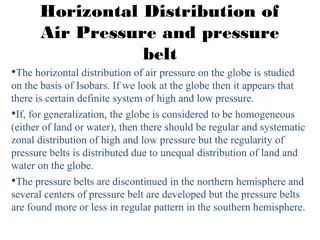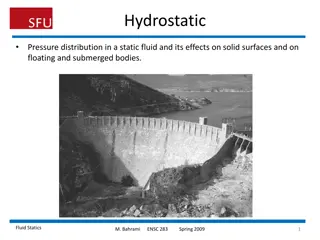Understanding Atmospheric Pressure Variations at Different Altitudes
Atmospheric pressure varies with altitude due to the weight of the air column above. This activity explores how Otto von Guericke's experiments with vacuum systems demonstrate the power of air pressure. Theoretical concepts of atmospheric pressure are discussed, highlighting its relation to gravity and air expansion. Using SensorLab sensors, students can measure and study atmospheric pressure changes at varying altitudes to create hypotheses and test them.
Download Presentation

Please find below an Image/Link to download the presentation.
The content on the website is provided AS IS for your information and personal use only. It may not be sold, licensed, or shared on other websites without obtaining consent from the author. Download presentation by click this link. If you encounter any issues during the download, it is possible that the publisher has removed the file from their server.
E N D
Presentation Transcript
How does atmospheric pressure vary? Measuring atmospheric pressure at different altitudes above sea level
How does atmospheric pressure vary? Measuring atmospheric pressure at different altitudes above sea level Objective The purpose of this activity is to study atmospheric pressure variations, as we reach higher altitudes, in order to create a hypothesis. The hypothesis will be tested by using the SensorLab air pressure and GPS sensors.
How does atmospheric pressure vary? Measuring atmospheric pressure at different altitudes above sea level Introduction and theory The aim of the introduction is to focus students on the lesson subject by refreshing acquired knowledge and asking questions which encourage research development. Key concepts from the theoretical framework, applied by the students during the lesson, are taught. Introduction A 17th century German lawyer, Otto von Guericke (1602-1686), interested in mathematics and engineering, conducted various experiments in vacuum systems.
How does atmospheric pressure vary? Measuring atmospheric pressure at different altitudes above sea level Introduction and theory One of his most dramatic experiments was made at Magdeburg in 1657, known as the Magdeburg hemispheres . Guericke used a vacuum pump to suck the air inside a hollow sphere. This sphere was formed by two identical bronze hemispheres, which had been perfectly fitted together due to the vacuum. An eight horse team was tied to each hemisphere, and then the two teams tried to pull apart and divide the sphere. Despite the sixteen horse-power the hemispheres could not be separated!
How does atmospheric pressure vary? Measuring atmospheric pressure at different altitudes above sea level Introduction and theory This experiment shows the power of air pressure that kept the hemispheres together. How would you explain what happened with the Magdeburg hemispheres ? What is the relationship between the vacuum inside the sphere and the air pressure outside the sphere?
How does atmospheric pressure vary? Measuring atmospheric pressure at different altitudes above sea level Introduction and theory Theoretical Atmospheric pressure is defined as the pressure exerted by atmospheric air on the surface area of earth, due to the force of gravitational attraction. Therefore, it is related to the weight of the air column on the earth s surface. However, air is a gas mixture and expands to use the entire volume available, exerting pressure, not only on the ground, but in all directions. Normal atmospheric pressure is equal to the pressure exerted by a mercury column at a sea level of 76 cm, at 0 C. We call this value atmosphere (atm.) and use it as a relative unit for pressure. Besides atmospheres, other pressure units are the mercury millimeters (mmHg), milibars (mbar) and kilopascals (kPa). So we have:
How does atmospheric pressure vary? Measuring atmospheric pressure at different altitudes above sea level Introduction and theory Carry out the experiment activity with your class so that at the end you ll be able to answer the following question: How does atmospheric pressure vary in response to changes in altitude?
How does atmospheric pressure vary? Measuring atmospheric pressure at different altitudes above sea level Introduction and theory Gravity force attracts air molecules toward the earth. It is therefore logical to assume that closer to the earth s surface there are more air particles than found at higher altitudes. This leads to a greater particle density as we approach the earth s surface, causing the existence of layers or stratus. Lower layers receive pressure from upper layers, creating yet further air density difference. This is similar to what we observed when we stirred earth into a glass of water. We found a greater concentration of earth next to the bottom of the glass, and therefore that in the water close to the surface was thinner than the suspension at the bottom.
How does atmospheric pressure vary? Measuring atmospheric pressure at different altitudes above sea level Introduction and theory We can therefore conclude that as we approach sea level, the greater the air density and the greater the atmospheric pressure. As we gain altitude the amount of air particles per unit area decreases. Therefore, the air is less dense and the pressure will decrease. Now students are encouraged to raise a hypothesis which must be tested with an experiment. Suppose you measure atmospheric pressure at the place you are right now. Do you think you could obtain your altitude? Assuming that you could, can you guess what altitude over sea level you would find?
How does atmospheric pressure vary? Measuring atmospheric pressure at different altitudes above sea level Activity description Students will evaluate air pressure variations at different altitudes on a field trip. They will use the barometer (or air pressure sensor) and GPS to register atmospheric pressure and altitude data at different points along the trip. Based on the results, students will relate both variables with their hypothesis.
How does atmospheric pressure vary? Measuring atmospheric pressure at different altitudes above sea level Resources and materials SensorLab USB connector cable
How does atmospheric pressure vary? Measuring atmospheric pressure at different altitudes above sea level Using the SensorLab and sensor a. Using the SensorLab To collect measurements with the SensorLab air pressure and GPS sensors, the SensorLab must be set up according to the following steps: Turn on the SensorLab by pressing Press and select SETUP by pressing Using go to the GPS Configuration Menu, pressing to enter and selecting the Activate GPS option by pressing Press two times to go back to the menu. Go to SETUP using the button and select it with Now select option SET SENSORS with
How does atmospheric pressure vary? Measuring atmospheric pressure at different altitudes above sea level Using the SensorLab and sensor Select only the barometer (or air pressure sensor) and GPS sensors and press Having done that you will return to setup, press one time and select SAMPLING RATE with the button, then select 1/min with button and press Press the button and select NUMBER OF SAMPLES pushing . Select 1000 with the button. To return to the measurements press two times. Then press to start measuring. Once you ve finished measuring stop the SensorLab by pressing (you will see the instruction Press SCROLL key to STOP ) and press
How does atmospheric pressure vary? Measuring atmospheric pressure at different altitudes above sea level Experiment The following steps explain how to perform the experiment: Define a path to ensure a significant elevation difference between the end and the start of the trail.
How does atmospheric pressure vary? Measuring atmospheric pressure at different altitudes above sea level Experiment At intervals during the trip measure the air pressure, especially at each sensible altitude difference. Once you have finished measuring turn the SensorLab off.
How does atmospheric pressure vary? Measuring atmospheric pressure at different altitudes above sea level Results and analysis The following steps explain how to analyze the experiment results: Connect the SensorLab to the computer using the USB communication cable or via the Bluetooth wireless communication channel. In the top menu click in the button. Select the last experiment of the list. Observe the graph displayed on the screen. Press the button and write notes on the graph, specifying your observations according to the moment you registered the data. Right click the y axis and set the minimum and maximum value according to your measurements. Round your minimum value down and your maximum value up, and enter these numbers into minimum and maximum .
How does atmospheric pressure vary? Measuring atmospheric pressure at different altitudes above sea level Results and analysis To see the map, make sure your computer is connected to the Internet, then click on the button which is in the top-right corner of the GlobiLab screen and then click on the button. In the top-right corner of the map, you ll see the words map and satellite . If you click on map, you ll see only street names. If you click on satellite, you ll see only the satellite image. If you click on satellite/label, you ll see the satellite image with the name of the streets. If you want to see the exact value of each point, place the mouse s arrow at the desired point on the map and a label with the values will appear. On the top-left corner of the map, you ll see the zoom and the cardinal points.
How does atmospheric pressure vary? Measuring atmospheric pressure at different altitudes above sea level Results and analysis On the right side of the map you ll see the color code scale. Right click the scale and use the set range to fill in the minimum and maximum air pressure values on the map. To move the map, click on it and move the mouse s arrow.
How does atmospheric pressure vary? Measuring atmospheric pressure at different altitudes above sea level Results and analysis How do the results relate to your initial hypothesis? At which point did you find the maximum atmospheric pressure value? Where did you find the minimum pressure values? What is the difference in pressure between the maximum and minimum values? Do you think it is statistically significant?
How does atmospheric pressure vary? Measuring atmospheric pressure at different altitudes above sea level Results and analysis The graph below should be similar to the one the students came up with.
How does atmospheric pressure vary? Measuring atmospheric pressure at different altitudes above sea level Results and analysis The measurements began at 1400 m.a.s.l. on a mountain where the experimentors recorded the minimum air pressure value. The altitude decreased during the trip towards the valley, causing an air pressure increase to a maximum of 750 m.a.s.l. (see line graph).
How does atmospheric pressure vary? Measuring atmospheric pressure at different altitudes above sea level Conclusions Following are some questions and answers which should be developed by the students in order to elaborate on their conclusions. Observe the chart from the theoretical background. How would you explain the relationship between atmospheric pressure and altitude? Explain. Students should establish that the chart shows an inverse relationship between altitude and pressure. At an altitude of 1400 m the environmental pressure obtained was 88 kPa, and at an altitude of 750 meters above sea level the pressure was 95 kPa, approximately. How did the pressure vary in response to changes in altitude? Students should describe the chart they obtained and explain the differences in air pressure.
How does atmospheric pressure vary? Measuring atmospheric pressure at different altitudes above sea level Conclusions What could you say about the molecular arrangement of air at altitude? Students should establish that at high altitude there are fewer molecules per volume unit, and thus less air pressure pressing down on earth. Therefore, the atmospheric pressure decreases. Is it possible to establish your altitude at a given location by measuring atmospheric pressure? Students should conclude that this is only possible if you have a point of reference to compare your results with. In this case, we were able to compare our results with the data given in the theoretical background.
How does atmospheric pressure vary? Measuring atmospheric pressure at different altitudes above sea level Conclusions Students should reach the following conclusions: Atmospheric pressure has an inverse relationship with altitude, i.e. as air goes up in altitude, pressure decreases. We may explain this equation by remembering that air next to sea level is being pressed down by the upper air layers, and is also attracted by a greater force towards the center of the earth. The air at sea level is much denser than air at altitude, and therefore a greater number of particles are exerting pressure on the earth s surface.
How does atmospheric pressure vary? Measuring atmospheric pressure at different altitudes above sea level Activities for further application The aim of this section is for students to extrapolate the acquired knowledge during this class through its application in different contexts and situations. Furthermore, it is intended that students question and present possible explanations to the experimentally observed phenomena. Further questions: How would you explain the clogged feeling in the ears at altitude? Students should associate the feeling of fullness or clogging in the ears with a response to altitude changes. At altitude the atmospheric pressure decreases causing a difference in pressure between the inside and outside of the middle ear, which is responsible for the blocked ear sensation.
How does atmospheric pressure vary? Measuring atmospheric pressure at different altitudes above sea level Activities for further application Acute mountain sickness is a disease developed at high altitudes with symptoms that include vomiting, dizziness and headache. How could you explain this reaction? Students should relate the symptoms of sickness to atmospheric pressure at altitude. They should establish that pressure changes at altitude may be an important factor in developing acute mountain sickness. They should also think of the thinner air at altitude remembering that there is also less oxygen. Our organism is not adapted to a low oxygen environment, and therefore reacts accordingly. According to the theoretical background, explain how suction cups work. Students should point out that when we press a suction cup against a surface we empty it of air, forming an internal vacuum. The suction cup will remain attached to the surface because of the pressure created by the external air.
How does atmospheric pressure vary? Measuring atmospheric pressure at different altitudes above sea level Activities for further application If you take a plastic mineral water bottle on a trip to high altitude, what do you think will happen when you reach the top of the mountain? Students should conclude that the lower pressure at high altitude will cause the bottle to expand, or even explode because the pressure inside the bottle will be higher than the pressure outside it.























